
How to Make SMS Your Number-One Revenue Channel
At the most fundamental level, there are two ways to boost SMS revenue:
Send more texts.
Text more people.
While we talk a lot about the nuance of things like message creative and audience segmentation, it’s important to remember that when you strip away all the razzle-dazzle, those are the two factors that matter most to your brand’s ability to drive revenue through SMS.
So, if SMS revenue is still lagging behind some of your other marketing and advertising efforts, the two places you should focus your attention and effort are:
Growing your subscriber base.
Increasing your send volume.
That’s it—simple as that.
Of course, simple doesn’t always equal easy. Don’t worry—we gotchu!
Here’s your guide to cashing in on SMS. 🤑
In this article (click to jump to a specific section):
Increase the Size of Your SMS Subscriber List
Ramping up your messaging frequency won’t do much good if nobody’s there to receive your messages. That’s why list growth should be at the top of every SMS strategist’s to-do list—especially during less promotion-heavy months. (Don’t add more to your plate in Q4 and mix list-growth efforts with BFCM campaign prep.)
Growing a sizable list of engaged subscribers takes time, and there aren’t a ton of shortcuts to doing it compliantly. It’s a slow burn, which can make it less exciting than other aspects of SMS marketing.
Just remember that every opt-in you drive now is an opportunity to convert later. So, keep your eyes on the revenue prize!
Let’s talk about the top three places to focus your subscriber acquisition efforts:
Your shop’s website
Your email list
Your social media channels
One important note on phone number collection: You must display the required compliance language at every opt-in point—regardless of the medium or channel. Anytime you ask someone to sign up for your text marketing, this verbiage must be visible:
*I agree to receive recurring automated marketing text messages (e.g. cart reminders) at the phone number provided. Consent is not a condition to purchase. Msg & data rates may apply. Msg frequency varies. Reply HELP for help and STOP to cancel. View our Terms of Service and Privacy Policy.
Additionally, make sure you either link "Terms of Service" and "Privacy Policy" to your terms of service and privacy policy pages—or that you include the actual URL for each page.
Okay, now let’s get after it!
Growing Your List on Your Website
First up: your website. You’re putting a lot of resources into driving traffic to your site, and you know that not every site visitor will become a customer right away.
But, making them an SMS subscriber is the next best thing, because it opens up the opportunity to engage with them one-on-one—and hopefully turn them into a customer eventually.
And for those who do make it all the way to purchase, adding them to your SMS list significantly increases your chances of earning their business again in the future.
Here are some low-effort, high-reward strategies for converting website traffic into SMS subscribers.
Checkout Collection
This is where many brands kick off their list growth efforts. When you enable phone number collection at checkout, customers see a checkbox they can select to sign up for your brand’s text marketing.

Example of compliant phone number collection at checkout
Those who opt in will become subscribers once they complete their order. Shopify and Shopify Plus merchants using Postscript can add checkout collection by following the steps laid out in this help article.
Back in Stock Collection
Back in stock collection allows shoppers to sign up for restock notifications if a product happens to be sold out. That way, even if they leave your site empty-handed, you have an easy way to bring them back to complete a purchase in the future.
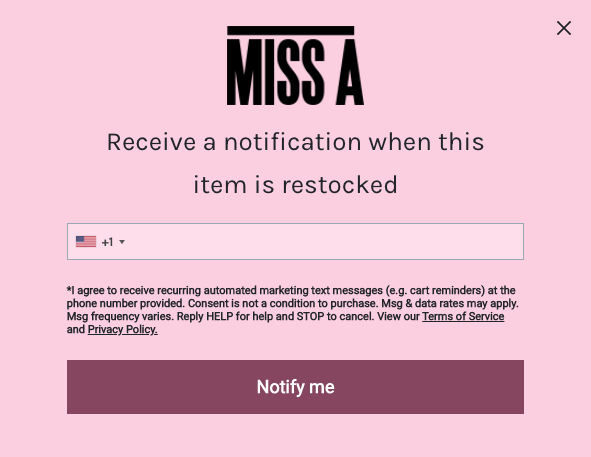
Shop Miss A's back-in-stock opt-in form
This opt-in appears directly on the product page for the out-of-stock item. Learn more about how it works in Postscript here.
Desktop, Mobile, and Banner Popups
Moving higher up the funnel, opt-in popups give you a tool for turning any website visitor into a subscriber, regardless of whether they view a product page or complete an order. Postscript offers three types of built-in popups (and we integrate with several popular popup platforms):
Desktop: Display is optimized for visitors who are browsing on a desktop or laptop computer.
Mobile: Display is optimized for visitors who are browsing on a mobile device.
Banner: Appears for all visitors and lives at the bottom of all website pages (so folks can opt in anytime during their browsing session, even if they close out of the other popups).
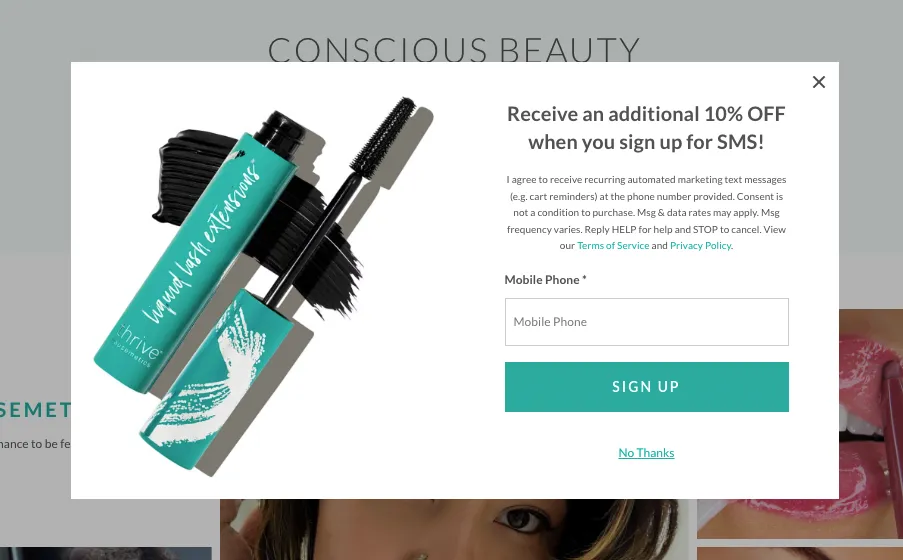
Desktop popup from Thrive Cosmetics

Mobile popup from Thrive Cosmetics

Banner popup from Wandering Bear Coffee
Popups typically incentivize opt-ins with a discount or other reward (e.g., “Sign up to get 10% off your first order.”). Learn more about Postscript’s popup capabilities here.
Growing Your List with Email
If someone likes your brand enough to subscribe to your emails, there’s a good chance they’ll subscribe to your SMS list, too. Email subscribers are familiar with your brand, and they are already high-intent. In fact, they may already be customers.
That makes email a highly effective acquisition strategy for SMS. Here’s how to put that strategy in action.
Templated SMS Opt-in CTA
Make sure all of your current email templates include a callout—either in the footer or a top banner—for recipients to opt into your SMS marketing by texting a particular keyword to your toll-free number (TFN) or dedicated short code (DSC). For example: Love our products? Get 20% off your next order when you sign up for our text messages. Just text LOVE20 to 54321.
Check out this resource for more info on creating unique opt-in keywords within Postscript.
Standalone Email Campaign
While adding an SMS-focused CTA to your email templates is a great way to slowly add subscribers over time, you’ll want to send an email campaign solely focused on your SMS program if you want to convert large numbers of subscribers quickly.
Start by sending one standalone email with a strong (and preferably, incentivized) CTA—and then plan out future efforts based on how well that email performs. New product about to drop? Let email subscribers know that folks on your SMS list will be the first to know. FOMO works!
Or, you could go ahead and build out a cadence that gives recipients multiple chances (and reminders) to opt in over the course of several weeks, with each send focusing on a different benefit of joining your SMS club.
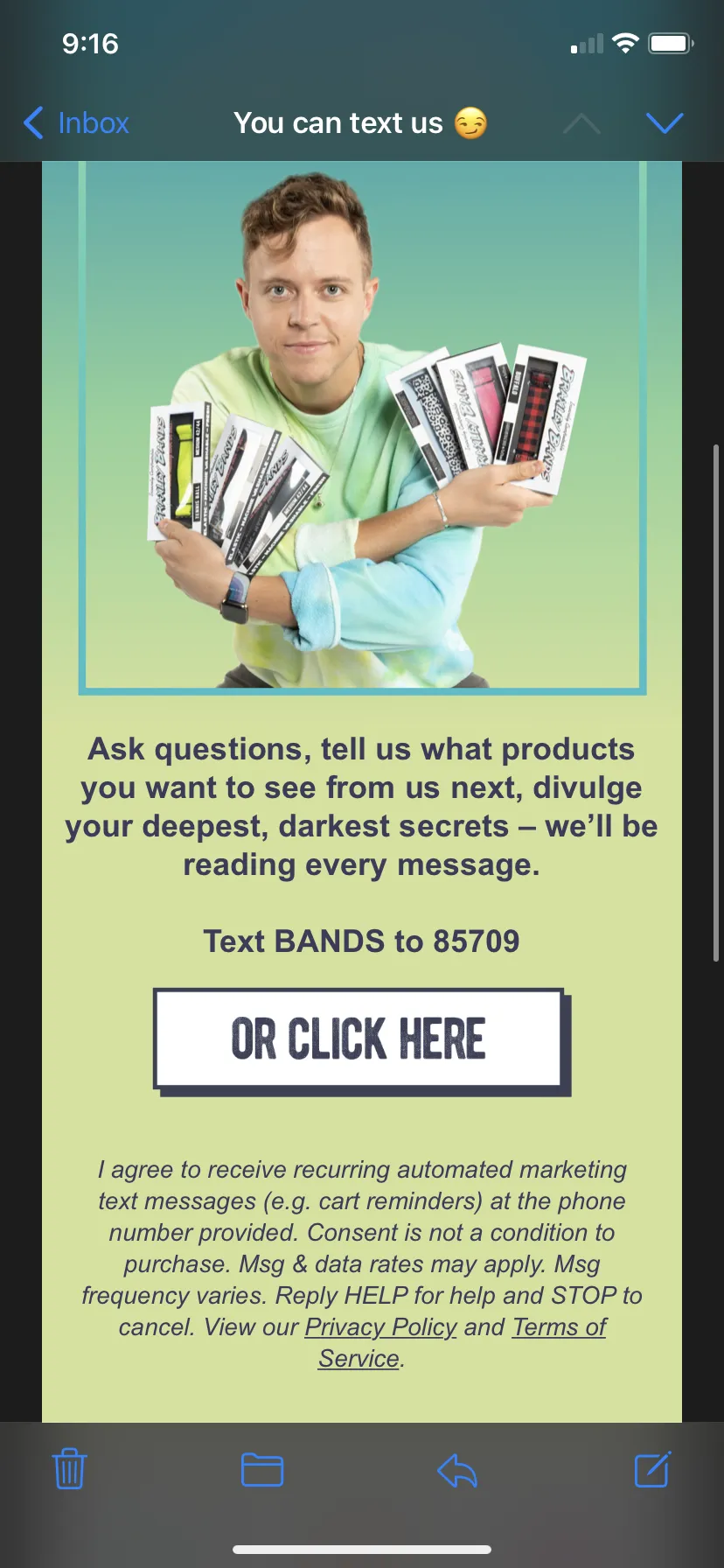
SMS opt-in email campaign from Braxley Bands
Check out this help center article for more tips on growing your list with email.
Growing Your List with Social Media
Like your email subscribers, your social media followers have already shown interest in connecting with your brand. They’ve indicated that they want to hear from you, which makes them an ideal audience for SMS.
Here are a few ideas for flipping social followers into text marketing subscribers. We’d recommend starting with your most popular social media platform (i.e., the one where you have the biggest community and the highest engagement).
Instagram is one of the best platforms for driving SMS opt-ins. Here are several ways you can use it to grow your list:
Create an Instagram story featuring your opt-in link as a sticker link. When users on a mobile device tap the link, it will launch their native mobile app with an opt-in message pre-populated. Then, all they have to do is hit the send button, and voila—they’ve subscribed.
Create an Instagram grid post promoting an opt-in keyword or directing followers to the opt-in link in your bio. Whereas stories disappear after 24 hours, grid posts remain until you remove them. We recommend publishing SMS-focused grid posts consistently so new followers can easily find them on your page.
Include a link to your SMS opt-in landing page among all the other links featured on your Instagram profile (e.g., through Linktree, Milkshake, or another link tool). Make sure your CTA for signing up is clear so you have the best chance of converting new followers who are poking around your profile.
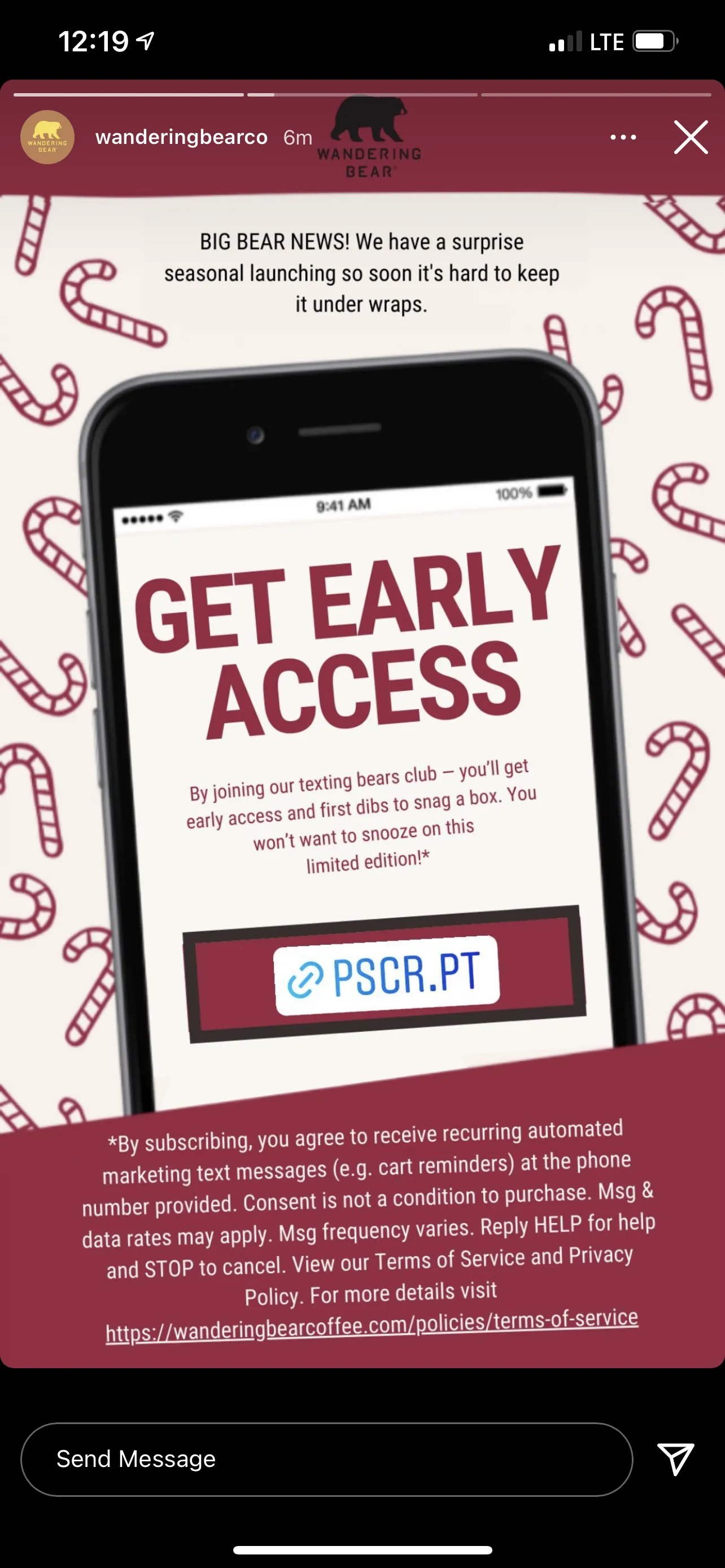
Instagram story with opt-in sticker link from Wandering Bear Coffee
For more details on using Instagram to grow your list—as well as examples—check out this help article.
Have a solid Facebook community? Make sure you leverage it to collect SMS subscribers. Here’s how:
Create a post inviting followers to opt in via keyword or short link (on Facebook, you can put your link in the post description itself).
Run a Facebook ad promoting the benefits of opting into your SMS marketing. These days, you pretty much have to pay for large-scale visibility on Facebook. If you’re already using Facebook ads to drive sales, then it should be pretty easy to add one for your SMS program.
Learn more about using Facebook to grow your list here.
TikTok
If you have (or are growing!) a strong follower base on TikTok, then you’ll definitely want to use it to collect SMS subscribers.
However, TikTok limits the way brands can use their platform for promotional purposes. For that reason, we recommend steering clear of:
Posting your short code or toll-free number in a video or live broadcast (including the description). TikTok actively flags media containing phone numbers.
Including your short code or toll-free number in your TikTok bio. TikTok actively flags accounts that display phone numbers.
Saying your short code or toll-free number in your TikTok bio. You guessed it—TikTok actively flags accounts that say phone numbers as part of their video or live broadcast.
All of that being said, here’s what you can do on TikTok:
Add a link to your compliant opt-in landing page alongside your other links (e.g., using Linktree or other alternatives).
Direct viewers to the link in your bio. For example: “We're getting ready for a big-time product drop over here. If you want first dibs, join our VIP SMS club. The link to sign up is in our bio!”
Learn more about using TikTok to grow your subscriber base in this help article.
Twitter is a great place to mobilize your most active followers to help you grow your subscriber list. The more interaction you can drum up, the more visible your tweets will be. Here are some ideas:
Add your opt-in short link to your Twitter bio. For example, you might add a line like, “Join our SMS club for exclusive access to sales and new product drops! [Insert Link Here].”
Pin a tweet with your opt-in link. You probably change out your pinned tweets throughout the year, but be sure to dedicate one of them to promoting your SMS program. If you offer an incentive for subscribing, encourage your followers to retweet and spread the love!
Tweet your opt-in link. Whether or not you pin it, you should definitely tweet out your opt-in link—or schedule out a series of tweets—to get the new subscriber train rolling. Encourage retweets to boost visibility even more!
Tweet a keyword image. Tweets with images get more engagement than those without, so share one promoting an opt-in keyword. Or, if you’ve already created similar images for other platforms, repurpose them for Twitter.
Learn more about growing your list with Twitter in this help article.
Text Subscribers Thoughtfully and Frequently
One of the biggest mistakes brands make is not sending enough texts. From what we’ve heard around the industry, this overly cautious approach to SMS stems from two main things:
Lack of clear guidance and best practices: SMS is still a relatively new channel, and many brands are afraid of “messing it up.” It’s an understandable fear. You’re messaging folks in the most personal of spaces, and you want to be respectful of that space. But you also want to use it to engage with them in the most meaningful way possible—and striking the right balance can seem daunting.
Blatant misuse of the channel: There’s no way around it—a lot of brands abuse SMS. Blinded by dollar signs, they pummel their audience with flash sale after flash sale. You don’t want your brand lumped in with those shops, so you’ve shied away from SMS altogether.
To unlock the full potential of SMS, though, you can’t let the missteps of others prevent you from charting your own path. When done right, SMS can add to the experience you deliver to your customers—not take away from it.
One important thing to remember is that subscribers opted into receiving your texts. They gave you permission to contact them. The key is messaging them the way they want to be messaged.
When messages are contextual, they feel natural—not intrusive. Brands that achieve this don’t have to worry about spiking unsubscribe rates when they send more texts. You wouldn’t block a friend whose texts make you feel happier and more connected, and that’s exactly how your texts should make your subscribers feel.
Finding Your SMS “Goldilocks” Zone
Before we get into some smart strategies for ramping up your send volume, let’s talk about best practices. As we explain here, every brand should be able to text each subscriber five times per month without seeing a major increase in unsubscribes.
“If your brand is not able to send 5 texts per month without seeing a major negative impact to revenue and unsubscribes, then it’s time to look at your message content and segmentation,” we wrote. “High-quality SMS creative and thoughtful segmentation help ensure that subscribers consistently receive engaging, personalized texts from your brand—exactly the kind that they want to receive. If that’s the case, their likelihood of opting out is low. On the other hand, if you’re merely batching and blasting—sending spammy messages to your full list—then it should come as no surprise that unsubscribes will follow.”
So, to find your ideal message cadence, the first step is getting your brand to that five-message-a-month threshold.
From there, you can test the impact of adding one additional message per month until you start seeing diminishing returns. In other words, as we noted here, “Not too many texts—and not too few. Just the right number to maximize your revenue and keep your audience engaged.”
Remember that not every send should be a full-list send—though you certainly don’t want to avoid those large sends entirely. You’re aiming for a healthy mix of broad campaigns, targeted campaigns, and subscriber-triggered automations.
Setting Up Key Automations
The more automations you have running, the more opportunities you have to deliver those subscriber-triggered messages—which are inherently more contextual than brand-initiated campaign messages.
Postscript features dozens of triggers and filters you can use to build highly specific automations. For example, you might set up an upsell automation for customers who have purchased a certain item but have not purchased another specific item. Or, you could create a post-purchase automation specifically for customers who spent over a certain dollar amount on their last order.
To start, though, we recommend getting the following key automations up and running, and then iterating on your automation strategy from there. (For more advanced automation tips, check out this blog post.)
Welcome Series Automation
Your welcome series is the message flow subscribers receive immediately after they opt in. But while you should absolutely use it to introduce your brand and your SMS program, your welcome series is so much more than a first impression.
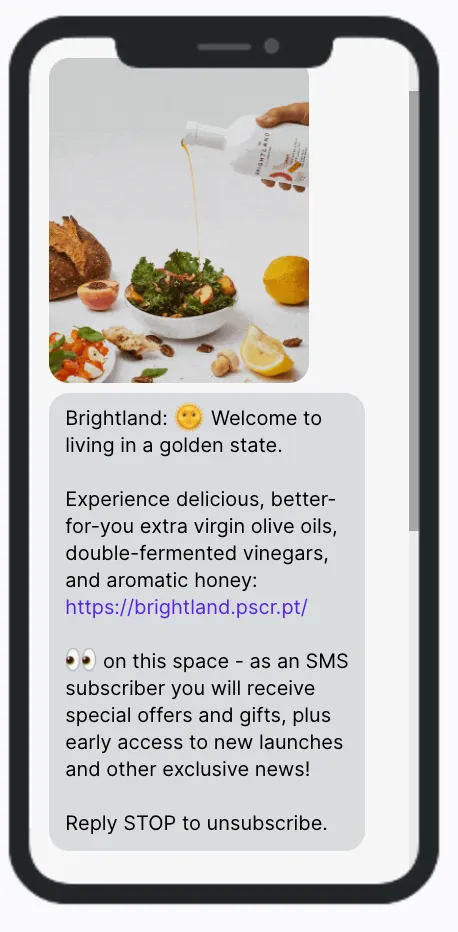
Message from Brightland's welcome series
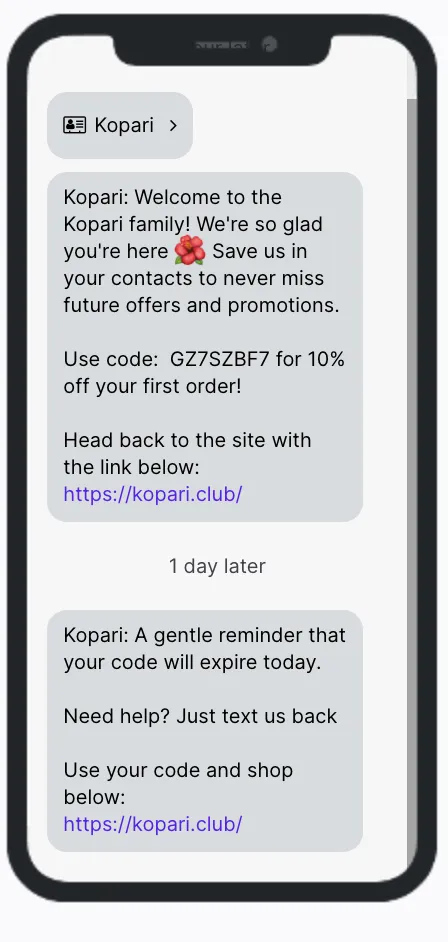
Two messages from Kopari's welcome flow, with contact card included
As explained here, our data shows that a new subscriber’s first 30 days are critical to retaining them in the long term, because the vast majority of unsubscribes happen early in their SMS journey.
Failing to engage with fresh opt-ins can lead to a disconnected experience for new subscribers. So, be sure to send them a two-to-three message flow introducing your brand (and perhaps even your founders), letting them know what they can expect from you, or even getting to know them via keyword replies (i.e., inviting them to text back with the keyword representing their product interests, which can help you better segment future sends).
While offering a discount to new subscribers is a nice gesture to thank them for opting in, it’s not required (unless you’ve promised it).
For more welcome series ideas, examples, and best practices, check out this blog post.
Abandoned Cart Automation
Abandoned cart automations are also incredibly important for ecommerce merchants, because they give shops a direct line to bottom-of-funnel shoppers. The automation fires when a subscriber starts—but does not complete—the checkout process. It really doesn’t get any more high-intent than that. In fact, abandoned cart automations yielded the second-highest CTR (Clickthrough Rate) and Conversion Rate across all product personas in our 2022 Benchmarks Report.
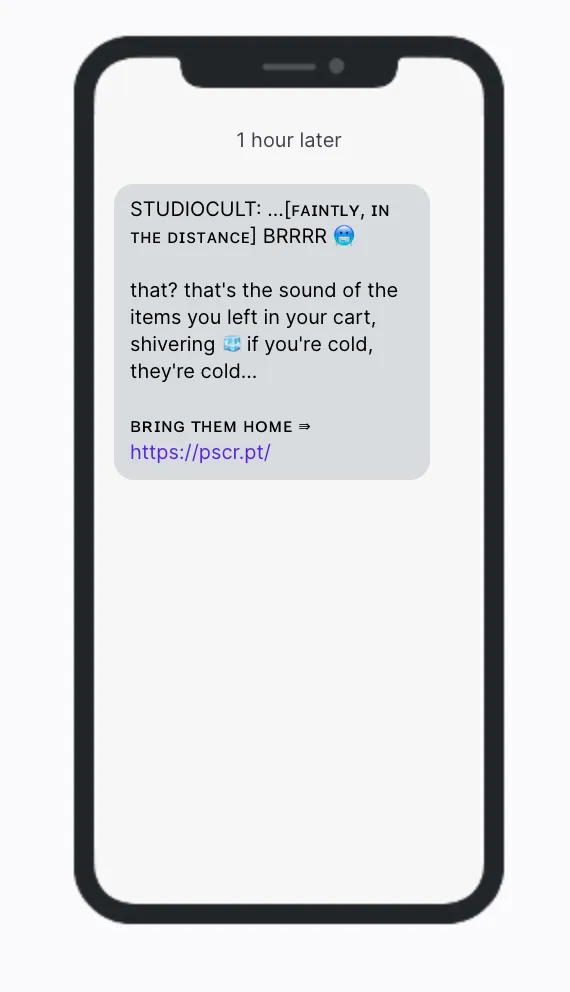
Abandoned cart automation from STUDIOCULT
Check out this help article for guidance on setting up an abandoned cart automation in Postscript.
Browse Abandonment Automation
Similar to abandoned cart automations, browse abandonment automations target higher-intent shoppers, which means they’re well positioned to convert. They just hit subscribers a little higher in the sales funnel. Subscribers receive this automated message when they’ve viewed a product on your site—but never started the checkout process.
This automation is great for marketing to subscribers in a highly personalized way. Based on the item viewed, you could serve up additional product information, customer testimonials or reviews, a bundled deal with a complementary product—the possibilities are endless.
Learn how to set up a browse abandonment automation in Postscript here.
Creating a Campaign Calendar
To reiterate, whereas automations are triggered by subscribers, campaigns are triggered by you. That makes them slightly less contextual, which might make you more reluctant to use them.
We get it—you don’t ever want to annoy your subscribers. But repetitive discount messages and batch-and-blast flash sale announcements give SMS campaigns a bad name. It doesn’t have to be like that!
This is where thoughtful planning comes into play. When you sit down and schedule out several messages in advance, you can more easily create the right amount of “breathing room” between sends. You’ll also have more time to come up with creative approaches to various sending opportunities.
That’s not to say you can’t fire off impromptu campaigns—in fact, we recommend it, especially if it speaks to a relevant current event or trend (like the day Instagram went down)—but we find brands that come up with a proactive plan are the most likely to stick with it.
Here’s an easy win. You already have an email calendar planned out, so simply add SMS strategies within that cadence. It’ll give you a holistic view of how frequently—and with which channels—you’re messaging your lists.
It’s important to mix up your campaign strategies so your messaging—and especially your deals—don’t become too predictable or repetitive. A good rule of thumb is planning your next month’s worth of campaigns about 2–4 weeks in advance and considering relevant campaign opportunities in the following two categories.
Seasonal Holidays, Events, and Celebrations
Seasonal happenings—including formal and informal holidays (like Fourth of July or National Pet Day, respectively), trending events (like the Oscars or March Madness), and widely recognized celebrations and observations (like Pride Month or Mental Health Awareness Month)—provide excellent opportunities to message your subscribers.
Postscript publishes a monthly roundup of these occasions—along with real text message examples from real brands—on our blog, with the newest edition always appearing at the top of the page. (Check it out here!)
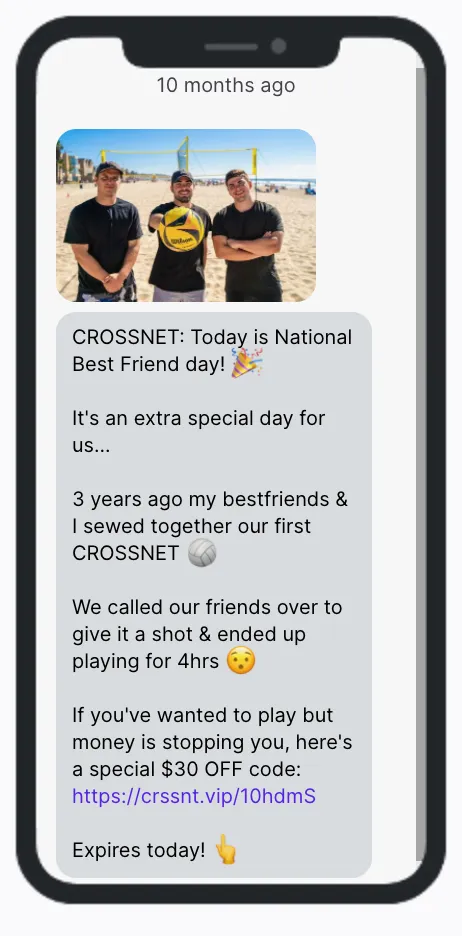
National Best Friends Day campaign from CROSSNET
Not every suggested holiday will make sense for your brand—and that’s okay. You want to be selective with the ones you believe will resonate most with your audience.
It’s also important to recognize that not every campaign needs to come with a discount or sale attached to it. In fact, we’d argue against that approach. Some campaigns are about driving conversation, engagement, and brand loyalty—full stop. We dive deeper into ideas and best practices for these types of campaigns here.
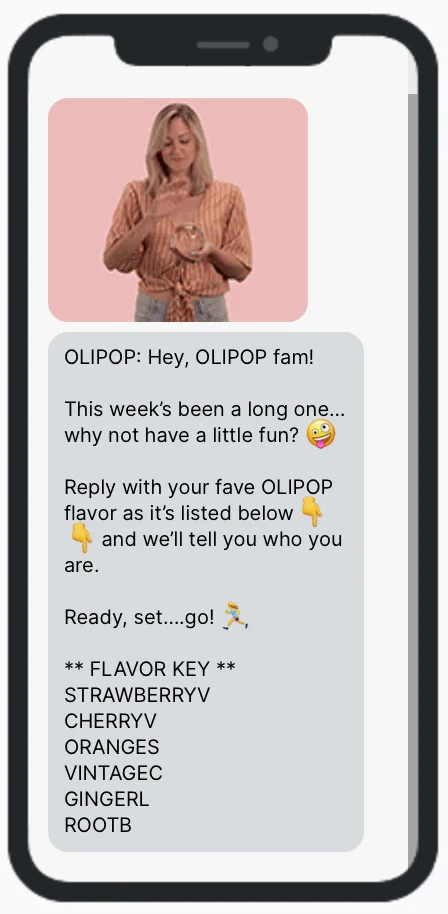
Keyword-driven conversational campaign by OLIPOP
Finally, keep in mind that you don’t have to send every campaign to your full list—nor should you. Get creative with specific messaging for specific segments of subscribers, and pay special attention to your VIPs.
Non-Seasonal Themes
In addition to scheduling out monthly campaign content in line with seasonal and timely occasions, try to incorporate at least one non-seasonal campaign strategy per month.
Ideas include:
New product drops (including VIP early access)
Featured products
Fan favorites (perhaps via sharing reviews or UGC)
Employee favorites
Bestsellers spotlight
Restocked product announcements
Site-wide sale announcements (including VIP early access for the really big sales)
SMS-only sales or deals
Content-centric campaigns (recipes, playlists, staff spotlights, etc.)
Conversational campaigns (interactivity via texting back responses, keywords, or photos)
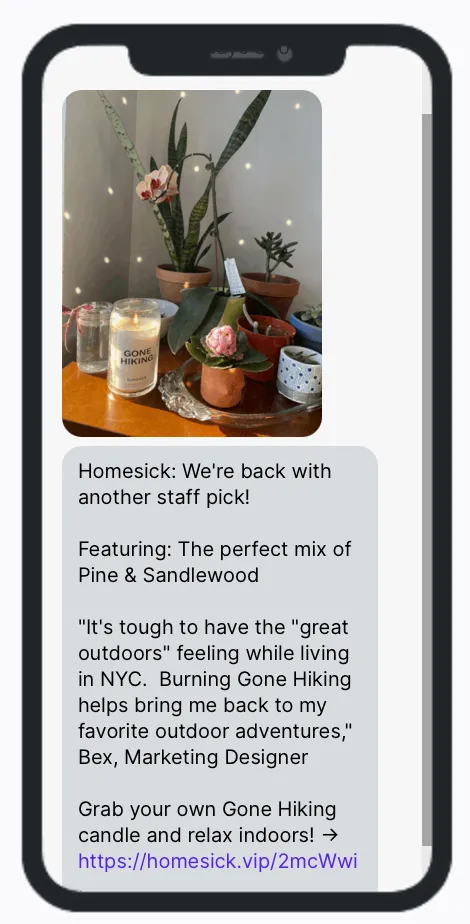
Staff pick campaign from Homesick
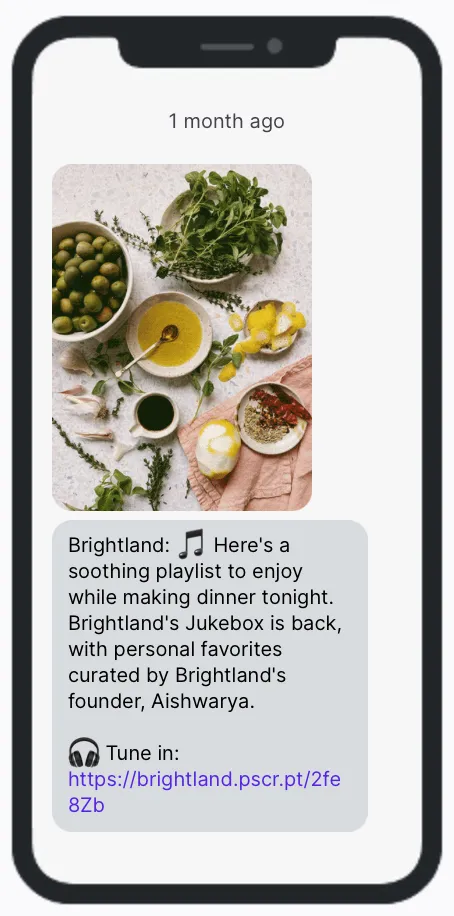
Playlist campaign from Brightland
For more creative campaign ideas (plus examples!) you can try out for BFCM—or any time of year—download the Ultimate BFCM Planner for SMS Marketers here.
Making SMS a big-time moneymaker for your brand isn’t complicated, but it does require strategy and discipline. Start broadening your acquisition efforts and increasing your send rate now, and you’ll see a positive impact to revenue within a few months. More importantly, you’ll build a completely owned channel that will reduce your dependence on other, more costly marketing and advertising strategies in the future.



